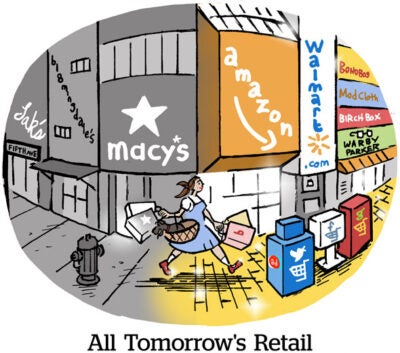Last week, at an industry event hosted by RTB House, a group of retailers took the stage to discuss their plans (and frustrations) with data-driven advertising this year. I think it’s worth revisiting some of the things they mentioned, partly because it’s useful, tactical information, but also as a reminder to other retail marketers and online merchants that nobody has this data-driven advertising thing down pat.
Here were the panelists:
- Kaila Maus, Director of Paid Media, Coach
- Jakub Rutkowski, Head of Digital Media, Allegro
- Ryan Pabelona, VP of Performance Marketing, REVOLVE
And below are a few topics that the group discussed.
On using Generative AI
MAUS: We’ve tapped into some AI tools not necessarily to create content but to inform the content. Most recently, we did some social listening to understand the themes and the types of content that resonate with Gen Z consumers.
We identified three key content pillars. One was around this idea of city streetscapes and how the younger consumer is really finding inspiration in those urban environments or nights out on the town. And then, beyond that, they’re wellness junkies, right? And third, they’re just looking for timeless fashion. They’re trying to move away from trends and find something that they can take with them every day.
PABELONA: We actually were able to reduce our return rate by showing AI-generated models. For example, REVOLVE has products with Japanese bag sizes. So we put an AI model to show how this would look and size it, because it’s hard online to sell purses or shoes [with unfamiliar sizes].
We also have all this social content that isn’t really something my team could use. But short, social videos have become so important recently to TikTok, YouTube, Meta – they’re all hooked on video. We’re really focused on how to get quality video to inform the AI. We’ve developed an internal tool that basically superimposes our product shots onto generative AI models, and does it in a good way. Like, they have all the fingers and toes, and the products look right.
On the art and science of measurement
PABELONA: We did a lot of upper-funnel marketing last year that we don’t typically do. We advertised on YouTube and TikTok upper funnel. We did display upper funnel. And the metrics were different.
Two years ago, we took a pretty big shift in terms of focusing toward incrementality testing. We still look at shipping and sales and ROAS. But we took all of our platforms and basically did either a geo-test or a cookie-split test and got a baseline of our incremental ROAS, which informed what our marketing mix should be.
And then we marry that with media mix modeling [MMM]. If you’re not doing MMM, you definitely should. There are free tools now. Our data science team uses Robyn, which is an open-source MMM [note: Robyn was created and open-sourced by Meta] that you can plug all your data into. We don’t take it as is as a source of truth. It’s more of a gut check.
RUTKOWSKI: After 25 years, we’ve finally grown up that 24-hour last-click attribution is not the optimal scenario. So we’re working on attribution.
But I must also say that we didn’t yet find the golden rule. I think attribution is like campaign optimization, as it’s something you need to constantly improve and optimize.
We have started about every quarter doing MMM, to take into consideration also how offline marketing is working, and monthly analysis of the brand. We don’t want to be purely focused on the performance and not look for the longer perspective.
MAUS: Measurement is something that keeps me up at night.
We are challenged as performance marketers, because it’s 2025, and a lot of us feel like this should be science at this point, and it’s not. There’s still a lot of art involved.
And we’re a little bit behind, I will say, as we just recently onboarded advanced analytics partners to do MMM and MTA for us. We’re pretty new and young in our journey there, but a lot of us at the organization are so excited to finally have this data. MMM we’re revisiting every six months or so, while MTA is refreshed on a weekly basis to be more like real-time optimization.
Some might see the advanced analytics as a slight silver bullet: “We finally have a source of truth!”
And the reality I’m finding is that it’s not a source of truth; it’s just another source. So doing the testing is so important. But even beyond that, we’re trying to really focus on how we as Coach build and put together that book of beliefs.
So my hope is that, if you asked me about our measurement approach in a year, it’ll probably be an answer [on measurement strategy]. I’m excited to see how it evolves.
On living in Google and Amazon’s world
PABELONA: Does anybody here like GA4? If so, I’d like to talk to you afterward. [Editor’s note: This was a mock threat, not a request for a conversation.]
We waited until the very last minute to transition to GA4, because we were not into it.
But the change made it more important to have other sources. Kaila [Maus, of Coach] was talking about, “What’s the source of truth?”
Well, with GA4, after the transition, a lot of channels look totally different. Because it’s a different form of attribution. So it became important for us to have an internal metric that’s more consistent over time, which we could reference to have a baseline.
MAUS: When GA5 comes out, what are you going to do?
PABELONA: Exactly. You need to make sure you’re measuring in some other way, like incrementality testing, to have a consistent way to look at things.
Google’s always changing something. Or changing their minds.
These quotes have been lightly edited and condensed.














